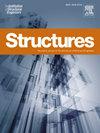Experimental and numerical investigations on flexural behavior of apex joints in aluminum alloy portal frames
IF 3.9
2区 工程技术
Q1 ENGINEERING, CIVIL
引用次数: 0
Abstract
Aluminum alloy portal frames (AAPFs) find extensive applications in lightweight and temporary structures owing to their light weight, excellent corrosion resistance, and ease of installation and disassembly. Existing design equations for cold-formed steel portal frame (CFSPF) apex joints are not applicable to AAPF apex joints due to significant differences in structural configuration. Therefore, dedicated research is needed to develop design guidelines for AAPF apex joints. Consequently, this paper conducts experimental and numerical investigations on flexural behavior of AAPF apex joints. Initially, bending tests are conducted on three AAPF apex joints, revealing failure modes including clamping plate buckling and beam failure. The flexural behavior of apex joints throughout the entire process is analyzed based on moment-rotation curves and moment-strain curves. Subsequently, finite element (FE) models are established and validated by comparing the FE results with the experimental results. Following this validation, parameter analysis is conducted considering the influence of beam cross-sectional dimensions, clamping plate dimensions, bolt dimensions, and layout. Finally, based on theoretical and numerical investigation, the calculation equation for the flexural capacity of AAPF joints is derived, offering valuable reference for engineering design.
铝合金门式框架顶点接头抗弯行为的实验和数值研究
铝合金门式框架(AAPF)由于重量轻、耐腐蚀性好、易于安装和拆卸,在轻质结构和临时结构中得到广泛应用。由于冷弯型钢门式框架(CFSPF)顶点连接的结构构造存在显著差异,因此现有的设计公式不适用于铝合金门式框架顶点连接。因此,需要进行专门研究,以制定 AAPF 顶点连接的设计准则。因此,本文对 AAPF 顶点接头的抗弯行为进行了实验和数值研究。首先,对三个 AAPF 顶点接头进行了弯曲试验,揭示了包括夹板屈曲和梁破坏在内的破坏模式。根据力矩-旋转曲线和力矩-应变曲线分析了顶点连接在整个过程中的弯曲行为。随后,建立了有限元(FE)模型,并通过比较 FE 结果和实验结果进行了验证。验证之后,考虑到横梁截面尺寸、夹紧板尺寸、螺栓尺寸和布局的影响,进行了参数分析。最后,在理论和数值研究的基础上,得出了 AAPF 接头抗弯能力的计算公式,为工程设计提供了有价值的参考。
本文章由计算机程序翻译,如有差异,请以英文原文为准。
求助全文
约1分钟内获得全文
求助全文
来源期刊

Structures
Engineering-Architecture
CiteScore
5.70
自引率
17.10%
发文量
1187
期刊介绍:
Structures aims to publish internationally-leading research across the full breadth of structural engineering. Papers for Structures are particularly welcome in which high-quality research will benefit from wide readership of academics and practitioners such that not only high citation rates but also tangible industrial-related pathways to impact are achieved.
 求助内容:
求助内容: 应助结果提醒方式:
应助结果提醒方式:


